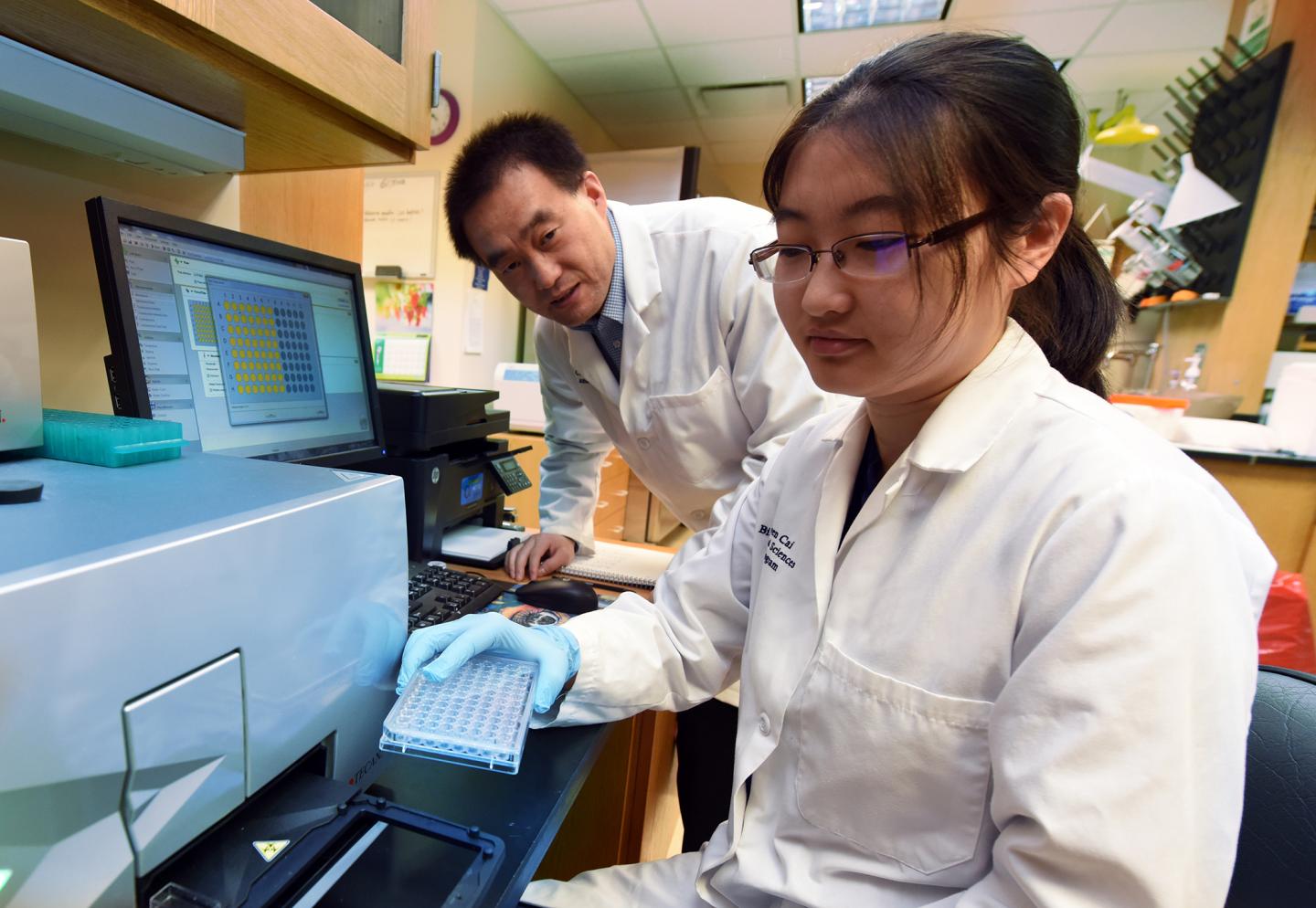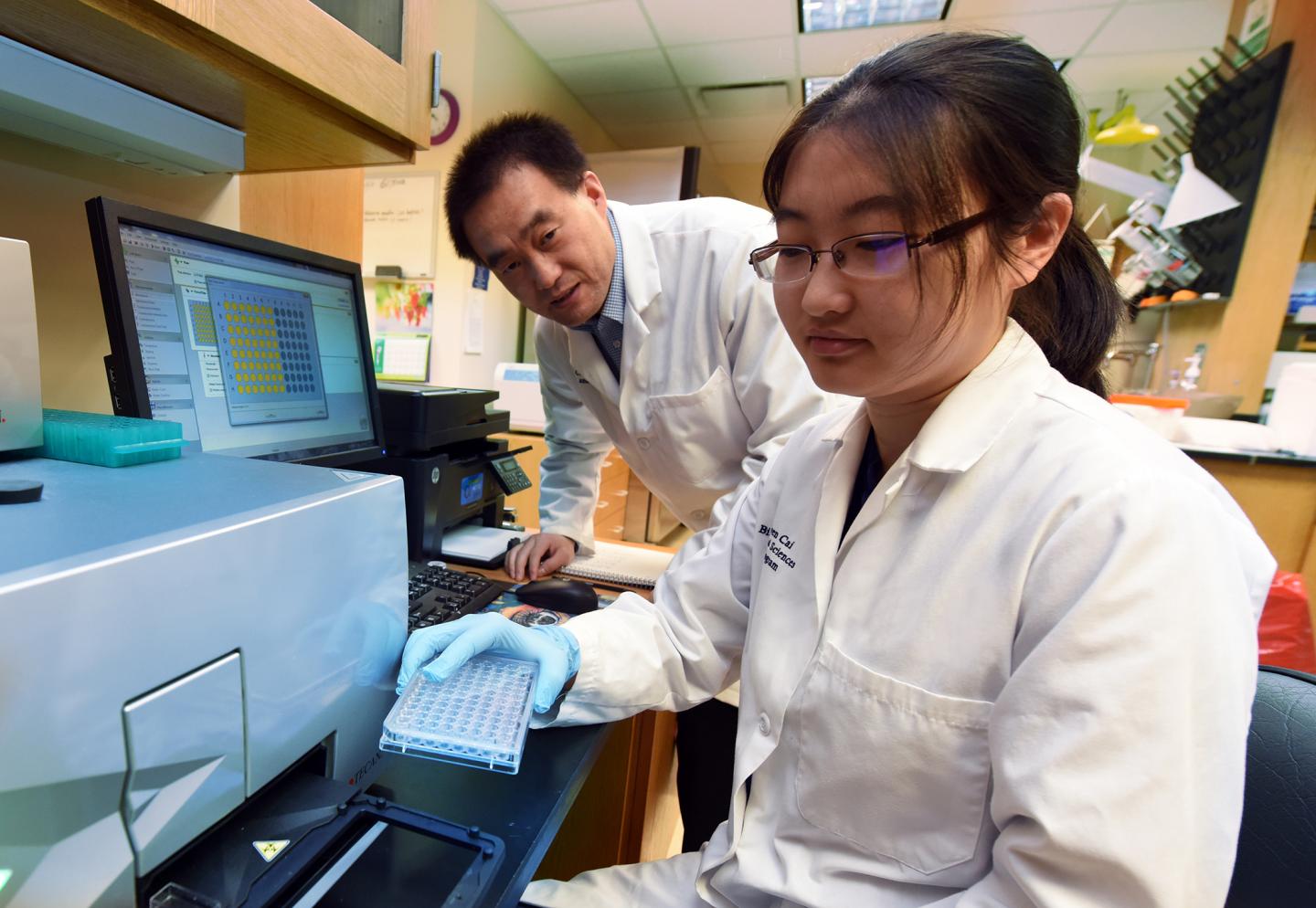
Credit: Phil Jones, Senior Photographer, Augusta University
AUGUSTA, Ga. (July 19, 2018) – In exfoliation glaucoma, a protein dandruff clogs the outflow pathway for the fluid in our eyes.
Scientists have evidence that variants of the same gene that enables us to make connective tissue by crosslinking proteins is associated with this unusual glaucoma.
Now they are looking in human eye tissue at a long piece of RNA that helps control expression of that LOXL1 gene with the idea that it may be a culprit in the destructive pileup of LOXL1 protein inside the eye.
A new, $440,000 grant from the National Eye Institute is helping Dr. Yutao Liu and his colleagues further explore the relationship between the gene and this long, noncoding RNA dubbed lncLOXL1.
A long-term goal is finding better treatment targets for this glaucoma, which is generally more aggressive and difficult to treat than its more common counterpart, primary open angle glaucoma, says Liu, vision scientist and human geneticist in the Department of Cellular Biology and Anatomy at the Medical College of Georgia at Augusta University.
"Variants of this gene are associated with the disease in every population we have studied worldwide," Liu says, including Caucasians, blacks in South Africa, the Japanese as well as Southeast Asians in India. They found the expression of LOXL1 consistently elevated early in the disease in every population. Variants are basically a slight difference in the most usual sequence of letters in the DNA.
High levels of LOXL1 protein that clog outflow tracts for the eye's aqueous humor also are a constant in all those patients. Still, there is conflicting laboratory evidence about the role of the suspect gene because neither removing or overexpressing it always results in the classic protein accumulation and high pressure inside the eye, at least in lab animals. So Liu and his team are also now looking at lncLOXL1, which regulates the gene's expression.
So far they have seen the expression level of the gene and lncLOXL1 correlate in both gene variations the scientists have seen in the human populations they have studied. They also have seen that as disease progresses, the gene expression goes down even as the protein piles up, typically at about age 60.
One of the many things they want to know now is what happens to the lncLOXL1 expression in disease. Does its expression also go down when disease becomes symptomatic, or does its parallel expression with the gene part ways at that point?
Knowing that will help determine whether it might one day need to be turned up or down to help patients, Liu says.
They also are further refining exactly what lncLOXL1 does and how it does it by looking at what genes/proteins are affected when it's knocked out and overexpressed.
"We are looking at what happens to expression of both the LOXL1 gene and its protein when we remove lncLOXL1 from the equation and when we overexpress it," Liu says.
They are also looking at other factors floating in the eye fluid with disease. Along with way too much protein, there are proinflammatory factors like transforming growth factor beta one, a protein with a wide range of functions from helping cells mature, grow, differentiate and even die, to promoting an inflammatory response; cytokines secreted by immune cells; and hydrogen peroxide, a product of high levels of oxidative stress.
They want to know if lncLOXL1 needs one or all these factors to do the damage they think it does. If they block these factors, for example, does the destruction still happen? Liu has already seen that treatment of human eye cells with transforming growth factor beta one impacts expression of this long, noncoding RNA. Now he is looking at things like what happens to levels of the LOXL1 protein.
They also are looking at the impact of environmental factors like ultraviolet light, since proximity to sunlight, like individuals who live in the mountains of Iceland, is an established risk factor for exfoliation glaucoma.
"From what we have seen so far, we don't think coding changes of this gene have anything to do with the disease, so it must be gene regulation," Liu says, and that could mean lncLOXL1.
A handful of years ago, Liu and colleagues at Duke University did a genetic association study – which looked at genetic risk factors – and found that variants of the gene LOXL1 in the noncoding region were associated with exfoliation glaucoma. The variance was in a sequence of the gene's DNA called the intron, which helps regulate gene expression, so how much of which proteins get made by the gene rather than actual protein production. Coding regions of genes that make proteins are called exons, and introns are considered non-coding regions.
The genetic variants appeared to impact not which proteins got made, but how much got made. With exfoliation glaucoma, it's definitely too much.
In addition to clogging fluid paths, over time the protein pileup appears to nibble away at the endothelial cells that line blood vessels as well as the pericytes, contractile cells that wrap around the endothelial cells and help give blood vessel walls strength and flexibility. The protein also weakens zonules, transparent tendons that help hold the lens of the eye in place.
Although inflammation contributes to the destruction in exfoliation glaucoma, the immune system often does not eliminate the dandruff-like flakes congesting fluid flow of the eye. Pressure inside the eye soars and the eyedrops that help the more common open-angle glaucoma by increasing outflow and/or decreasing fluid production don't work. Surgery to improve outflow often does not work long either.
The current studies are primarily using eye tissue from the lens capsule of 20 patients with exfoliation glaucoma as well as 20 patients who needed cataract surgery and are considered the controls. One thing both populations have in common is they are older, which is when cataracts and symptoms of exfoliation glaucoma both tend to surface.
Liu notes that not everyone with one of the known gene variants develops exfoliation glaucoma, and that as with many diseases, it's likely a combination of genes and environment that's causative.
The aqueous humor directly provides nutrition to the eye and the invaluable fluid is normally replaced about every 90 minutes.
In recent years, long, noncoding RNAs, which as the name implies are longer than some of their colleagues like microRNA, have been associated with an increasing number of diseases including a wide variety of cancers and cardiovascular disease.
###
Media Contact
Toni Baker
[email protected]
706-721-4421
@MCG_AUG
http://www.augusta.edu/mcg/





